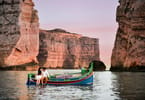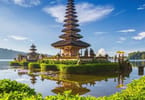UTUROA, Raiatea—Captain James Cook, the great explorer of the Pacific, was the first European to “discover” Raiatea, when he anchored the Endeavour in the lagoon at Opoa, south of here, in July 1769. Ironically, it’s the fact that it is pretty well “undiscovered” by the west today that gives this lush island its charm.
Unlike neighbouring French Polynesian islands like Tahiti, Bora Bora and Moorea, with their posh resorts geared to mass tourism from North America and Australia/New Zealand, Raiatea doesn’t have a well-developed tourist infrastructure.
That means it’s in many ways redolent of the South Pacific of old, a sleepy island that W. Somerset Maugham, chronicler of the South Seas in the first quarter of the last century, might find familiar today.
Uturoa is the administrative centre of the island, but it’s still a sleepy small town that really only comes alive when a cruise ship docks and on Sunday afternoons when people pour in from outlying villages for the cockfights in the local arena. It’s so laid back that drivers don’t only leave the car windows open in the heat of the day, they even leave the doors open.
The town dates from the 1820s when the Rev. John Williams of the London Missionary Society began spreading Christianity through the South Pacific islands. The Protestant church just north of town has a black granite memorial stone to Williams, with a marker in several languages.
But, surprisingly, there’s no memorial to Omai, a Raiatea native who was the first Polynesian to be seen in Britain. Captain Cook, on his second voyage to the South Seas in 1773, befriended Omai and took the youth back with him.
The “noble savage” became an instant hit in the salons of London. Great artists painted him (a portrait by Joshua Reynolds hangs in London’s Tate Gallery). And he was introduced to King George III and Queen Charlotte at Kew Palace.
The Raiatean also made quite an impression on Dr. Samuel Johnson, the great writer and lexicographer (and the man who compiled the first English dictionary).
Omai spent two years in England before returning to the South Pacific with Cook, serving as translator in Tonga and the Society Islands, before Cook landed him on the island of Huahine, where the crew built him a house.
Cook first landed, having breached the surrounding lagoon, at Te Ava Moa Pass. The pass is revered in Polynesia as the departure point for the huge canoes that carried emigrants to discover Hawaii and New Zealand. Nearby is a marae (the word means sacred site) called Taputapuatea. The stone shrine, dedicated to the ancient Polynesian god Oro, was restored in the 1960s. It spreads over about a hectare [2 1/2 acres].
Raiatea is also famous for its firewalkers, barefoot natives who walk over hot coals. It’s a skill handed down from father to son, but, ironically, visitors are unlikely to see it being performed here because, I’m told, the firewalkers are snapped up by the big resorts in Tahiti and Bora Bora, which put on displays for their guests. ACCESS
هن آرٽيڪل مان ڇا وٺو:
- Uturoa is the administrative centre of the island, but it's still a sleepy small town that really only comes alive when a cruise ship docks and on Sunday afternoons when people pour in from outlying villages for the cockfights in the local arena.
- Omai spent two years in England before returning to the South Pacific with Cook, serving as translator in Tonga and the Society Islands, before Cook landed him on the island of Huahine, where the crew built him a house.
- UTUROA, Raiatea—Captain James Cook, the great explorer of the Pacific, was the first European to “discover” Raiatea, when he anchored the Endeavour in the lagoon at Opoa, south of here, in July 1769.






















